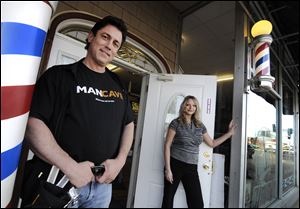
Shear fight ensues over barber poles' use
Mich., Minn. become fronts for debate
3/15/2012
At Cahill Salon & Barber Parlor in the St. Paul suburb of Rosemount, Minn., husband and wife owners Joel and Lisa Martin differ on barber pole legislation. He likes the proposed limits; she does not.
ST. PAUL, Minn. -- Friendly arguments aren't hard to find in a barbershop, but try cutting in on a hallowed symbol -- that red, white, and blue pole -- and it may be time to hide the scissors.
Steeped in history and symbolism, those iconic cylinders on storefronts across America are an increasing source of friction between barbers and beauticians. Minnesota and Michigan are the latest fronts in a spreading legislative campaign to reserve the swirling poles for barbers. The proposals, which often include fines for offenders, are driving a new wedge in a trade where gender lines have long run deep.
"The barber pole is the oldest sign in town besides the cross. It should not be displayed where there is not a licensed barber," said Charles Kirkpatrick of Arkansas, a barber since 1959 who keeps tabs on such legislation for the National Association of Barber Boards of America.
For many, the only real difference between a barber and hairstylist is the clientele they serve. But barbers say the tools of their trade and unique services they provide make them different, and that laws are needed to prevent beauty parlors, salons, and other establishments from passing themselves off as barbershops, including chain shops that bear the barber name and logo but don't have a single licensed barber on site.
Cosmetologists argue that haircuts are haircuts, and say the protective efforts are silly and chauvinistic.
"They're still trying to hang onto the vestiges that say they're special. I can cut a man's hair. Why shouldn't I be able to put a barber pole up?" said Jeanie Thompson, president of the Minnesota Salon and Spa Association and owner of a beauty parlor.
As the story goes, the red on the pole signifies blood, the white stands for bandages and the blue represents veins. The symbolism dates from a time when barbers also performed surgical duties from teeth extraction to bloodletting.
Barbers and cosmetologists both deal in hair, but there are distinctions in the crafts. A barber -- a term derived from the Latin word for beard -- is uniquely permitted to offer shaves with a straight-edge razor and specially trained to use shears and clippers. Cosmetologists also cut and style hair. But unlike barbers, they sometimes provide manicures, pedicures, and an array of spa-type services as well.
Licensing requirements in the hair trade vary from state to state and by profession. In most cases, they depend on hundreds of hours of training and a yearly fee.
At least 10 states have rules or laws that reserve the pole for barbers. Alabama and North Carolina considered going that route in 2010, but their bills stalled.
Ohio long ago outlawed the pole's use by anyone but barbers. State inspectors find about a dozen violations a year. Howard Warner, executive director of the Ohio State Barber Board, said regulators can impose a $500 fine, but usually just order the pole be taken down.
"We're not out to beat anyone up or take their money," Mr. Warner said. "Most of the time it's done innocently."